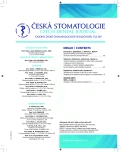Occlusal Contacts during Protrusion
(Original Article – Epidemiological Study)
Authors:
K. Francová 1; J. Zapletalová 2; I. Voborná 1; M. Eber 1
Authors‘ workplace:
Klinika zubního lékařství LF UP a FN, Olomouc
1; Ústav lékařské biofyziky LF UP, Olomouc
2
Published in:
Česká stomatologie / Praktické zubní lékařství, ročník 116, 2016, 2, s. 29-39
Category:
Original articles
Overview
Introduction and aim:
Many criteria of ideal occlusion, especially of the static occlusion, were generally accepted. On the contrary, other parameters, especially of the dynamic occlusion, are subject to ongoing debate. Epidemiological studies contribute to this discussion.
The aim of the presented epidemiological study was to describe occlusal contacts during protrusion, to classify them and to find out prevalence of protrusive interferences.
Methods:
100 young adults, dental students, 60 women, 40 men, were examined. The age of the participants was 20–32 years (median 22). Subjects had well-preserved dentitions. 55 subjects had orthodontic therapy in their history. Occlusal contacts were detected during protrusive movement, from the maximal intercuspidal position to the edge-to-edge position. All movements were guided by participants themselves. Occlusal contacts were detected by basic clinical method, in three steps. First detection was conducted visually, second with articulating paper. Third assessment served as an additional check of the first two assessments. Subjects themselves reported, which teeth they feel to be in occlusal contact during each movement. Occlusal contacts during laterotrusion among the same pool of participants were discussed in a former study.
Results:
During protrusion, upper central incisors and lower central and lateral incisors were mostly in contact. Occlusal contacts on upper lateral incisors and upper and lower canines were less often. There were a few contacts on premolars and molars. Occlusal contacts during protrusion were classified in detail. In most students, occlusal contacts were located only on frontal teeth (83 subjects). From these, 52 had contacts only on incisors and 31 on both incisors and canines. 17 students had contacts on both lateral and frontal teeth. In six cases, lateral contacts were located on premolars, in 11 cases on molars. Protrusive interferences were defined as occlusal contacts on lateral teeth during protrusion. The prevalence of protrusive interferences among participants was 17 percent.
Conclusion:
This epidemiological study described in detail occlusal contacts during protrusion, classified occlusal contact patterns during protrusion and reported prevalence of protrusive interferences in young adults.
Keywords:
occlusal contacts – occlusal interferences – occlusion – protrusion – eccentric movements of the mandible
Sources
1. Al-Nimri, K. S., Bataineh, A. B., Abo-Farha, S.: Functional occlusal patterns and their relationship to static occlusion. Angle Orthod., roč. 80, 2010, s. 65–71.
2. Dawson, P. E.: Functional occlusion: from tmj to smile design. St. Louis, Mosby Elsevier, 2007. ISBN-13: 978-0-323-03371-8.
3. Francová, K., Eber, M., Zapletalová, J.: Functional occlusal patterns during lateral excursions in young adults. J. Prosthet. Dent., roč. 113, 2015, č. 6, s. 571–577.
4. Gazit, E., Lieberman, M. A.: The intercuspal surface contact area registration: An additional tool for evaluation of normal occlusion. Angle Orthod., roč. 43, 1973, č. 1, s. 96–106.
5. Ingervall, B., Hähner, R., Kessi, S.: Pattern of tooth contacts in eccentric mandibular positions in young adults. J. Prosthet. Dent., roč. 66, 1991, s. 169–176.
6. Mohl, N. D.,Zarb, G. A., Carlsson, G. E., Rugh, J. D.: A textbook of occlusion. Chicago, London, Berlin, Sao Paulo, Tokyo, Hong Kong, Quintessence Publishing, 1988. ISBN 0-86715-167-6.
7. Okeson, J. P.: Management of temporomandibular disorders and occlusion. St. Louis, Elsevier Mosby, 2008. ISBN 978-0-323-04614-5.
8. Pahkala, R., Qvarnström, M.: Can temporomandibular dysfunction signs be predicted by early morphological and functional variables? Eur. J. Orthod., roč. 26, 2004, s. 367–373.
9. Sadowsky, C., BeGole, E. A.: Long-term status of temporomandibular joint function and functional occlusion after orthodontic treatment. Am. J. Orthod., roč. 78, 1980, s. 201–212.
10. Sadowsky, C., Polson, A. M.: Temporomandibular disorders and functional occlusion after orthodontic treatment: results of two long-terms studies. Am. J. Orthod., roč. 86, 1984, s. 386–390.
11. Scaife, R. R., Holt, J. E.: Natural occurrence of cuspid guidance. J. Prosthet. Dent., roč. 22, 1969, s. 225–229.
12. Sreekumar, A. V., Rupesh, P. L., Pradeep, N. J.: Nature of occlusion during eccentric mandibular movements in young adults. Contemp. Dent. Pract., roč. 13, 2012, s. 612–617.
13. The Academy of Prosthodontics. Glossary of prosthodontic terms. J. Prosthet. Dent., roč. 94, 2005, s. 10–92.
Labels
Maxillofacial surgery Orthodontics Dental medicineArticle was published in
Czech Dental Journal

2016 Issue 2
Most read in this issue
-
Importance of Centric Relation Registration by the Patients with Complete Dentures
(Practical Report) -
Dentigerous Cysts of Jaws
(Original Article - Retrospective Clinical Study) -
Maturogenesis Part 2. Irrigation Protocols, Intracanal Medication
(Review) -
Streptococcus Mutans and its Influence on Dental Status
(Original Article – Comparative Study)
